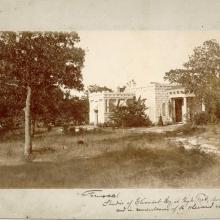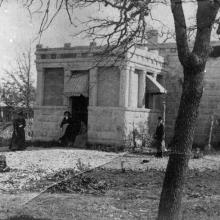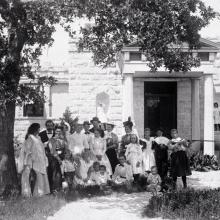
Elisabet Ney Museum
Elisabet Ney, b 1833- d 1907304 E. 44th St., Austin, TX 78751 - view on Google Maps
512-458-2255
512-458-2255
“Shall not our dwellings, our public buildings, our factories, our gardens, our parks,
reflect in reality the loveliness of our artistic dreams?”
—Elisabet Ney
In 1892, Elisabet Ney, a prolific classically-trained sculptor, moved to Austin and built “Formosa,” a remarkable stone villa that served as her studio and home. Here she created iconic statues of Sam Houston and Stephen F. Austin, among others. Ney was also a philosopher, a feminist, a humanist and a historian. The museum is dedicated to her art and legacy.
ABOUT
In 1892, European sculptor Elisabet Ney (1833-1907) began construction of a distinctive limestone castellated structure in Austin, Texas. In this studio, christened “Formosa,” Ney would sculpt legendary Texans and other personalities. She also assembled a remarkable collection of sculptures that she had created as a bold and charismatic young Berliner years before, including representations of notables like Jacob Grimm, Arthur Schopenhauer and Giuseppe Garibaldi. Extraordinary works that combine elements of Romantic and Neoclassical inspiration, produced with the support of her close friend and patron King Ludwig II, also reside here. Her Texas works—made at Formosa—include iconic representations of Sam Houston, Stephen F. Austin, and more. The plaster “drafts” of these works live here, while their marble companions are located in sites all over Texas and at the Smithsonian and the National Statuary Hall in Washington, D.C.
Ney spent the last years of her life in Austin, working vigorously and gathering a salon that ranged from artists and musicians to politicians and priests. Holding forth on creek side benches, she presided over discussions of politics, philosophy and art that lasted long into the warm Texas nights. Her protégées went on to become leaders in the arts, letters, and the Texas suffragist movement.
Ney was a colorful character, as a few quotes and facts demonstrate. She was married to Edmund Montgomery, a Scottish medial doctor and prolific philosopher who also moved to Texas, but she never took his name. She insisted on being addressed as “Miss Ney” since she was “no man’s property.” She said: “Women are fools to be bothered with housework. Look at me; I sleep in a hammock which requires no making up. I break an egg and sip it raw. I make lemonade in a glass, and then rinse it, and my housework is done for the day.” When she sculpted the famous German philosopher Arthur Schopenhauer, she impressed him so much that he referred to her by name in his diary, indicating that she had forced him to reconsider his views on women’s capacities and role in society.
At her death, her friends preserved the contents of the beloved studio. It has operated as a museum ever since. In 2007, a Master Plan was created that included the recreation of a historic prairie landscape, evocative of that she experienced and loved every day of her life in Austin. A cornerstone of Austin’s Hyde Park Historic District, the Elisabet Ney Museum continues to refresh and energize, inspire and enchant visitors of all ages.
Ney spent the last years of her life in Austin, working vigorously and gathering a salon that ranged from artists and musicians to politicians and priests. Holding forth on creek side benches, she presided over discussions of politics, philosophy and art that lasted long into the warm Texas nights. Her protégées went on to become leaders in the arts, letters, and the Texas suffragist movement.
Ney was a colorful character, as a few quotes and facts demonstrate. She was married to Edmund Montgomery, a Scottish medial doctor and prolific philosopher who also moved to Texas, but she never took his name. She insisted on being addressed as “Miss Ney” since she was “no man’s property.” She said: “Women are fools to be bothered with housework. Look at me; I sleep in a hammock which requires no making up. I break an egg and sip it raw. I make lemonade in a glass, and then rinse it, and my housework is done for the day.” When she sculpted the famous German philosopher Arthur Schopenhauer, she impressed him so much that he referred to her by name in his diary, indicating that she had forced him to reconsider his views on women’s capacities and role in society.
At her death, her friends preserved the contents of the beloved studio. It has operated as a museum ever since. In 2007, a Master Plan was created that included the recreation of a historic prairie landscape, evocative of that she experienced and loved every day of her life in Austin. A cornerstone of Austin’s Hyde Park Historic District, the Elisabet Ney Museum continues to refresh and energize, inspire and enchant visitors of all ages.
Did you know...?
Ney routinely slept on the roof of Formosa, which she accessed via a trap door she named the “Skytrap.”SPECIAL RESOURCES
For researchers, we have original documents that relate to Elisabet Ney’s life and time in Texas. We also have a photography collection, and rare books on Ney and her art. The first art museum in the state, the Texas Fine Arts Association, was established at Formosa in 1911, and we have documents and images from its early years.view on Google Maps
WHAT TO DO HERE
- Take art/history/architecture/science tours
- Stroll the recreated prairie landscape
- Tour the Hyde Park Historic District neighborhood
- Soon to be added: additional facility with classrooms and gallery space
YOU CAN ALSO SEE THE ART HERE:
- Ney’s works can be seen at the Texas State Capitol, the Smithsonian, the National Sculpture Hall, the United States Capital, and in museums in Germany and Western Europe.









